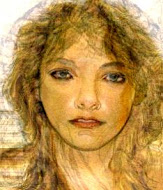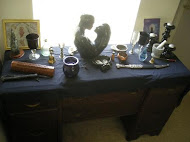Monday Make A - will return next week. In honor of Mabon, here is just a bit more info for you...
* Kore Chant *
author unknown, from Oceanna
According to one Greek myth, Autumn begins when Persephone returns to the Underworld to live with her husband, Hades. This is the tale...
Demeter's daughter, known as Kore at this time, was out picking flowers in a meadow when the Earth opened, and the god Hades dragged the girl into the Underworld Kingdom to be his wife. Kore's name changed to Persephone when she became the wife of Hades. For nine days Demeter looked everywhere for Kore, to no avail. In despair, she finally consulted the Sun god Helios, who told her that her brother Zeus had given the girl to Hades. Furious to hear the news, Demeter left Olympus and wandered the Earth disguised as an old woman. She finally settled in her temple at Eleusis. She cursed the Earth so it yielded no crops. Zeus became frantic and sent her a message as to why she had done this. She responded by stating to Zeus that there would be no renewing vegetation on Earth until her daughter, Kore, was returned to her. Zeus sent Hermes into the Underworld for the girl. Hades, not wanting to give up his wife permanently, enticed Persephone to eat pomegranate seeds before she returned to her mother. Upon learning of this trick, Demeter again despaired, until Zeus declared that Persephone-Kore would live with her husband during half of the year, and return to live with her mother during the other half. In gratitude, Demeter lifted her curse on the Earth, thus creating Spring at the time of her great joy of her daughter's return; and Fall at her time of great sorrow when her daughter returned to the Underworld to live with her husband, Hades.
Kore Chant for the Fall Equinox
Her name cannot be spoken,
Her face was not forgotten,
Her power is to open,
Her promise can never be broken.
All seeds She deeply buries,
She weaves the thread of seasons
Her secret, darkness carries,
She loves beyond all reason.
She changes everything She touches, and
Everything She touches, changes. [Repeat--chant.]
Change is, touch is; Touch is, change is.
Change us! Touch us! Touch us! Change us!
Everything lost is found again,
In a new form, In a new way.
Everything hurt is healed again,
In a new life, In a new day.
[Repeat any and all verses.]
* Harvest Customs *
From Curiosities of Popular Customs And of Rites, Ceremonies, Observances, and Miscellaneous Antiquitie (link is to full book available online)
By William S. Walsh; J.B. Lippincott Company;
Copyright 1897
From early times the ingathering of the harvest has afforded occasion for revelry and thanksgiving. When the Jews inhabited Palestine the festival of Pentecost embraced a thanksgiving for a bountiful harvest; but, as the wheat is not gathered in Northern Europe or America at the time of Pentecost, flowers take the place of the first-fruits in the synagogues. The Romans had their Cerealia, or feasts in honor of Ceres. The Druids celebrated their harvest festival on November 1, the Japanese and Chinese each celebrate one at the close of their year. The American Thanksgiving is an acknowledgment of the blessings of the year in general and the bounties of the harvest in particular. In pre-Reformation times in England Lammas-Day was marked by the presentation of a loaf made of new wheat in the churches by every member of the congregation. Afterwards the feast of Ingathering or Harvest-Home, known in Scotland as the Kern, was a peculiarly secular method of celebrating the close of the harvest. This still has its local survivals, although they are fast passing away before the modern innovation of a general harvest festival for the whole parish, to which all the farmers are expected to contribute, and which their laborers may freely attend. This festival is commenced with a special service in the village church, beautifully decorated for the occasion with fruit and flowers, followed by a dinner in a tent or in some building sufficiently large, and continued with rural sports, and sometimes includes a tea drinking for the women.
Nevertheless, as Canon Atkinson says, we cannot even yet use the past tense in speaking of the old harvest-home. "In the northern part of Northumberland," writes Henderson in his "Folk-Lore of North England" (1879), "the festival takes place at the close of the reaping, not the ingathering. When the sickle is laid down and the last sheaf of corn set on end, it is said that they have 'got the kern.' The reapers announce the fact by loud shouting, and an image crowned with wheat-ears and dressed in a white frock and colored ribbons is hoisted on a pole by the tallest and strongest men of the party. All circle round this 'kern-baby' or harvest-queen and proceed to do justice to the harvest-supper." In some places "this nodding sheaf, the symbol of the god," is quite small, fashioned with much care and neatness, and plaited with wonderful skill; in others it is large and cumbersome, taking a strong man's strength to bear it. In Scotland it is called "the maiden," and is dressed like a doll. It is preserved in the farm-house above the chimney-piece. The youngest girl in the harvest-field is supposed to have the privilege of cutting "the maiden." Its head is formed of ears of oats; a broad blue ribbon is tied in a bow round the neck, and a skirt of paper completes the costume of "the maiden." In the northeast of Scotland the last sheaf is known as the "clyack," or "cailleach" (old woman), and is dressed up and made to look as much like an old woman as possible. It has a white cap, a dress, a little shawl over the shoulders, fastened with a sprig of heather, an apron turned up to form a pocket, which is stuffed with bread and cheese, and a sickle is stuck in the string of the apron at the back. At the harvest feast the cailleach is placed at the head of the table, the company drink to her, and in the evening the lads dance with her.
The manner of escorting the last load to the barn varies in different places. In many parts of England it was borne in a wagon known as the hock-cart. A pipe and tabor went merrily sounding in front, and the reapers, male and female, tripped around in a hand-in-hand ring, shouting and singing. Herrick's description shows how ancient is this custom:
Come forth, my Lord, to see the cart
Drest up with all the country art.
The horses, mares and frisking fillies
Clad all in linen white as lillies.
The harvest swains and wenches bound
For joy, to see the hock-cart crown'd.
About the cart heare how the rout
Of rural younglings raise the shout;
Pressing before, some coming after,
Those with a shout, and these with laughter.
Some blesse the cart; some kisse the sheaves;
Some prank them up with oaken leaves:
Some crosse the fill-horse; some with great
Devotion stroak the home-borne wheat;
While other rusticks, lesse attent
To prayers than to merryment,
Run after with their breeches rent.
In some provinces it was a favorite practical joke to lay an ambuscade along the road, and from the vantage-point of some tree or hill to drench the hock-party with water. An old song with many variants still survives at the bearing home of the last load. Its usual form runs as follows:
Havest home! harvest home!
We've ploughed, we've sowed,
We've reaped, we've mowed,
We've brought home every load.
Hip, hip, hip, harvest-home!
Here is a glimpse of an East Anglian custom:
"The sun is setting behind the old windmill as we cross the field of stubble; from a group of harvesters comes a woman who, with a low courtesy, asks us for 'largess.' As we pass along we hear merry shouts and cheering, and presently round the corner of the road comes a fine team of horses, mounted by two lads dressed in the garb of women, while the wagon is filled with the last load of corn, and merry youths and maidens ride above it. The wagon stops, and the riders give us three cheers, and then on they go to the village green amidst much laughter and bright songs."
The custom is known locally as "Hallering Largess," and has been described as a certain rhythmic chant, rendered with action and gesture, and followed by a certain number of shouts, in return for gifts. When they have received the offering they shout thrice the words "Halloo, largess," which may be a corruption of a la largess. The ritual appears to be as follows. The laborers gather in front of the house, and form a ring by joining hands. They bow their heads very low towards the centre of the circle and give utterance to a low deep mutter, saying "Hoo-Hoo-Hoo;" then they jerk their heads backward and utter a shrill shriek of "Ah! Ah!" repeated several times. The Lord of the Largess, the leader of the band, then cries, "Holla, largess," which is echoed by the company, and thus the performance ends, a very interesting survival of old usuages.
In Herefordshire a final handful of grain was left uncut. But it was tied up and erected under the name of a mare, and the reapers then, one after another, threw their sickles at it, to cut it down. The successful individual called out, "I have her!" "What have you?" cried the rest. "A mare, a mare, a mare!" he replied. "What will you do with her?" was then asked. "We'll send her to John Snooks," or whatever other name, referring to some neighboring farmer who had not yet got all his grain cut down. This piece of rustic pleasantry was called "Crying the Mare." It is very curious to learn that there used to be a similar practice in so remote a district as the Isle of Skye. A farmer having got his harvest completed, the last cut handful was sent, under the name of Goabbir Bhacagh ("the Cripple Goat"), to the next farmer who was still at work upon his crops, it being of course necessary for the bearer to take some care that, on delivery, he should be able instantly to take to his heels and escape the punishment otherwise sure to befall him.
"In the southeastern part of Shropshire," says the Rev. C. H. Hartshorne in his "Salopia Antiqua," p. 498, "the ceremony is performed with a slight variation. The last few stalks of the wheat are left standing; all the reapers throw their sickles, and he who cuts it off cries, 'I have her, I have her, I have her!" on which the rustic mirth begins; and it is practiced in a manner very similar in Devonshire. The latest farmer in the neighborhood, whose reapers therefore cannot send her to any other person, is said to keep her all the winter. This rural ceremony, which is fast wearing away, evidently refers to the time when, our country lying all open in common fields, and the corn consequently exposed to the depredations of the wild mares, the season at which it was secured from their ravages was a time of rejoicing, and of exulting over a tardier neighbor."
Mr. Bray describes the same custom as practiced in Devonshire, and the chief peculiarity in that instance is that the last handful of the standing grain is called the Nack. On this being cut, the reapers assemble round it, calling at the top of their voices, "Arnack, arnack, arnack! we have'n, we have'n, we have'n," and the firkin is then handed round; after which the party goes home dancing and shouting.
Clarke in his Travels (1812) gives this account of a harvest-home festival in Cambridge:
"At the Hawkie, as it is called, or Harvest-Home, I have seen a clown dressed in woman's clothes, having his face painted, his head decorated with ears of corn, and bearing about with him other emblems of Ceres, carried in a wagon, with great pomp and loud shouts, through the streets, the horses being covered with white sheets; and, when I inquired the meaning of the ceremony, was answered by the people that 'they were drawing the Harvest Queen.'" (Vol. ii. p. 229.)
At harvest suppers in Dumfriesshire and Lincolnshire "the old sow," or "Paiky," used to make her appearance. This curious animal was nothing more nor less than two men dressed up in sacks to impersonate the visiting quadruped. The head was filled with cuttings from a furze-bush. The animal pranced around before the supper, pricking every one it approached. "I used to be very much afraid of it when I was a child," says a correspondent of Notes and Queries, Eighth Series, ix. 128. "That was a part of the harvest supper I never could like."
In some parts of Scotland a similar figure seems to have been called "Auld Glenae," as witness the lines in a poem on "Harvest-Home" published in Blackwood's Magazine for June, 1821:
But tumbling, rolling, sprawling on his way,
Comes in the straw-clad masker, "Auld Glenae;"
A lengthen'd pole adorns his better paw,
Well swathed with ribbons, and well wrapp'd with straw.
Like shaggy bear he heaves his limbs along,
And drives, and leaps, and bustles through the throng;
Tries every art the younger folks to "scar,"
And only joins the reel, the sport to mar;
Trips up the dancer in his figure pace,
And thrusts his stubble presence in each face;
With Lizy foots the droll duett away,
And capers to the tune of "Auld Glenae,"
Then winds his bunchy arms her waist about,
And bears aloft the farmer's daughter out;
"And wha can this be now?" each damsel cries;
"What can he want wi' Lizy?" each replies.
"Aweel," rejoins a third, "she's nae great prize!"
A rural celebration akin to the English, and known as the Fete of the Big Sheaf, survived until recently in Canada and closed the harvest season among the habitants in the neighborhood of Bay St. Paul. The last sheaf, made large, was put on the last cart-load of grain as an emblem of abundance; the lads and lasses, decorated with ears of grain, walked on each side of the load, and sang some of their national songs on the way to the house. "According to the usual ceremony," says the author of an article on "The Canadian Habitant" in Harper's Monthly, vol. lxvii. p. 389, "the master of the house sits in a large arm-chair at the head of the room, and awaits with a joyful and contented air the arrival of his people. These soon come trooping in, led by the eldest son, who carries in one hand a fine sheaf of wheat all decorated with ribbons, and in the other hand a decanter and a glass. He advances to the master of the house, gives him the sheaf, wishes him as good a harvest every year of his life, and pours him out a glass of brandy. The old gentleman thanks him, and drinks off the glass. Then the son goes round the room and serves the company; after which they pass to the next room for supper, composed of mutton, milk, and pancakes with maple syrup. After supper the decanter and glass go their rounds again, and then the young man who presented the sheaf asks his father to sing a song. Songs, dances, and other amusements close the festival. "As this pretty ceremony fell into disuse some years ago, the priest of one of the parishes on the south shore of the St. Lawrence took it under his own patronage, and made it a Church festival by carrying the Big Sheaf into the choir of the church and saying mass over it. But even this duller rite is now seldom witnessed: the farmers instead pay the priest to say a mass as thanks for the harvest."















2 comments:
Amazing how much fascinating lore you included in your blog entry. If you want to know a little more about pomegranates themselves, check out www.floreantpress.com and read about Dr. Gregory Levin's, "Pomegranate Roads: A soviet botanist's exile from Eden". Best, Barbara
Invest in Ripple on eToro the World’s #1 Social Trading Network...
Join 1,000,000's who have already discovered easier methods for investing in Ripple...
Learn from profitable eToro traders or copy their trades automatically.
Post a Comment